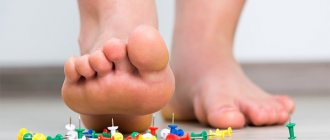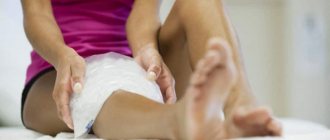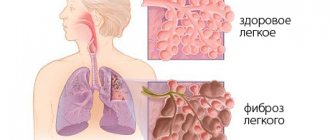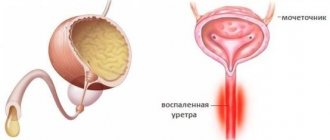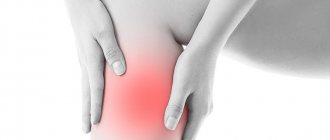Flat feet are an extremely common pathology among adults. It accounts for 25% of all visits to an orthopedic doctor. Among all foot deformities, flat feet account for 80% of cases. The disease progresses slowly but constantly without treatment. Over time, it leads to severe pain, limits a person's physical activity and leads to complications in the foot, spine and large joints of the lower limb. Let's talk about whether it is possible to cure flat feet in adults without surgery and when there is a need for surgical treatment.
Causes and symptoms
All children have flat feet at birth. Typically, by the age of 5, arches are formed: longitudinal and transverse. In childhood, flat feet are considered normal. It does not require correction with insoles or orthopedic shoes.
But as an adult, the foot should not be flat. However, flat feet develop in at least 15% of the adult population. It can be congenital or acquired. Congenital is extremely rare. Acquired by origin can be:
- static – due to prolonged standing;
- rachitic – a consequence of previous rickets (develops due to a disorder of calcium metabolism, mainly caused by a lack of vitamin D);
- paralytic - the result of damage to peripheral nerves or diseases of the central nervous system;
- traumatic – the result of a foot injury (damage to bones, joints, muscles, tendons).
The most common type is static flatfoot. Its symptoms depend on the stage of the pathology:
- Stage 1 – patients complain of pain and fatigue of the calf muscles of the legs, which appear only after a long walk;
- 2nd degree – pain with minimal loads, the first signs of foot deformation;
- 3rd degree – severe deformation of the foot and its expansion.
Static flat feet are the result of constant overload of the feet. It leads to weakened muscles and sprained ligaments. It usually develops in people who stand for a long time, lift and carry heavy objects.
Do flat feet need to be treated?
There is no doubt that treatment is necessary. The point is not only that pathology causes pain and discomfort to a person and limits his physical activity. It also increases the risk of other musculoskeletal diseases.
Flat feet reduce the spring (shock-absorbing) function of the foot. As a result, the vibration load on the spine increases and joints suffer. Patients with flat feet have a higher risk of scoliosis, osteochondrosis, and deforming osteoarthritis of large joints of the lower limb.
Thus, if signs of foot deformation appear, you should consult a doctor immediately, since flat feet need to be cured as quickly as possible. The disease is prone to progression. In addition, it causes many complications that are difficult to treat.
Hallux valgus becomes a frequent complication of transverse flatfoot. This is a deformity of the first (big) toe, which is popularly called a “bunion.” The disease is 20 times more likely to develop in women than in men. A predisposing factor is considered to be congenital weakness of the ligamentous apparatus of the foot. The situation is aggravated by wearing tight high-heeled shoes. Severe deformities may require surgical treatment.
Symptoms of transverse flatfoot, main causes
With transverse flatfoot, the transverse arch of the foot becomes thicker and the forefoot widens. The term “spread out” appears in the literature. As a result, the performance of the muscles attached to the big toe changes. The big toe seems to bend inward. Symptoms of transverse flatfoot include:
- severe aching pain in the feet;
- burning sensation in the lower leg or muscle cramps in the legs;
- feeling overwhelmed and tired at the end of a working day.
If transverse flatfoot is developed, it is in a deep stage, there is severe pain in the hip joints. The phenomenon is dangerous and provokes the occurrence of arthrosis.
Types of flat feet
This type of flatfoot is associated with standing for a long time due to work activity; excess weight (including pregnancy, which contributes to rapid weight gain); decreased muscle tone during sedentary activities; getting injured; aging of the body and other nuances.
If a girl likes to walk in heels for a long time, transverse flat feet gradually develops. In such shoes, there is a redistribution of body weight to the transverse arch, which is not ready for heavy loads. The arch is easily deformed.
Insufficiency of the ligamentous apparatus is called the main cause of the development of transverse flatfoot.
How to treat flat feet?
There are conservative and surgical treatment methods. In the vast majority of cases, conservative methods are used.
How flat feet are treated depends on the stage of the pathology and the presence of concomitant foot deformities. Typically, at stage 1, massage, gymnastics, and arch supports in shoes are used. At stage 2, individual insoles, physical therapy, and myostimulation are required to strengthen muscles. At stage 3, conservative treatment can be the same as at stage 2. But sometimes they resort to surgical intervention if a radical improvement cannot be achieved without surgery.
Before treating flat feet in adults, the doctor must conduct an examination. Basic diagnostic methods:
- plantography - obtaining foot prints with subsequent decoding;
- radiography – to visualize the bones of the foot;
- podometry – change in the nature of walking;
- computer pedobarometry is the most accurate method that measures pressure during standing and walking on different parts of the foot (allows you to ideally select orthopedic insoles).
In conservative treatment, the most important role is played by the use of orthopedic insoles or shoes. At stage 1 of flat feet, patients can buy ready-made insoles. However, they do not take into account the individual configuration of the foot, and therefore have only a symptomatic and not a corrective effect. Pre-made insoles relieve pain, but over time they can further weaken the muscles. Therefore, the disease can progress with their use.
The best option is individually selected and custom-made insoles. They not only reduce symptoms, but also help eliminate foot deformities.
How to do without surgery?
Flat feet do not require surgical intervention at an early stage of its development. In the absence of pain, if the discomfort is not annoying, you can take an alternative route:
- perform muscle stretching exercises;
- rest more, do not put heavy stress on your feet;
- apply cold lotions;
- use orthopedic insoles, bandage devices;
- do special gymnastics;
- undergo massage sessions;
- using foot baths, alcohol tinctures, herbal decoctions.
It is also recommended to normalize blood pressure and weight to reduce the risk of further development of foot deformity.
Can flat feet be treated with insoles?
Flat feet in the initial stages, without accompanying foot deformities and without arthrosis of the joints, can be cured with the help of insoles or orthopedic shoes. Insoles should only be made to order for a specific person. They are worn at least 5-6 hours a day. The course of treatment lasts from 2 to 4 years or more. The desired result is achieved in 60% of patients. The rest show improvement, but the disease is not completely cured.
Important conditions for the effectiveness of insoles:
- ideal conformity to the topography of the plantar surface of the foot;
- the absence of areas of increased pressure on the foot, which over time can lead to structural changes in soft tissue structures;
- creating conditions for training the muscles of the arch when walking.
Custom insoles affect the degree of muscle tension, joint position, and tendon tension. They also have an effect on proprioceptive sensitivity and contribute to better control of the dynamics of the human body. Good insoles not only relieve symptoms and correct foot deformities, but also improve posture and form a correct gait.
Exercises to treat flat feet
Performing special gymnastics will help get rid of discomfort, relieve pain, and gradually help restore the correct shape of the foot. Necessary:
- walk barefoot with your toes raised, trying to raise them as high as possible . Move first forward, then in the opposite direction;
- alternately walk on your toes and then on your heels, taking from 3 to 8 steps - short, with straight knees;
- slowly move the left leg back, resting on the toe, gradually lowering onto the entire sole. Repeat for the right leg. Do 10 times for each;
- lean on the outer edge of the foot, squeezing your toes a little, and walk back and forth a couple of times;
- from the starting position, when your feet are shoulder-width apart, rise onto your toes and smoothly lower onto your heels 10 times;
- perform while sitting or lying down - clasp the soles of your feet with your hands and press them close to each other, trying to bring the toes and heel of your left foot as close as possible to the right and vice versa;
- imitate the Lezginka dance , moving energetically on your toes or with support on your entire foot.
Treat flat feet on time. Folk remedies are your best assistant.
Making insoles
The main elements of creating insoles for flat feet:
- custom size;
- reconstruction of the arch of the foot;
- energy-saving depreciation;
- optimal thermoregulation.
Methods for planning the production of insoles are mechanical and computer. Although mechanical methods were historically the first, today the computer method is increasingly used in modern clinics.
The mechanical method involves obtaining a cast of the foot. In the future, orthoses are made on its basis. However, the technique has one huge drawback: it does not take into account the load on the foot when walking. The impression is taken in a static body position. However, when walking, areas of overload shift, and in different ways for different people. The cut is adjusted subjectively, based on the patient’s feelings, not on objective measurements.
The computer method is more accurate. Pedobarography is performed using a special apparatus. Many parameters are assessed: the position of the direction of the patient’s center of body mass, his movement when walking. There are 5 zones of greatest load on the plantar surface:
- finger;
- metatarsal (metatarsophalangeal joints, rollover axis);
- medial middle region;
- lateral medial region;
- the heel area, which is the axial support.
Based on the results, the structure of the integral load graphs is assessed. A model of the insole for manufacturing is formed. After its production, the orthosis is adjusted to the patient, based not on his sensations, but on the data of pedobarography and photoplantometry.
The use of individual insoles allows obtaining positive treatment results after 1.5 years in 85% of patients. Their pain and muscle fatigue when walking decrease or disappear. Measurements show an increase in arch height. Further treatment can be carried out using other insoles. The examination and orthoses are made again, as the configuration of the foot changes. In a few years, in this way, a person can completely recover from flat feet, after which the need for further use of insoles will disappear.
Should I use ready-made insoles?
You can often find orthopedic insoles and shoes on the Internet, orthopedic salons, pharmacies and medical equipment stores. They are much cheaper than those performed individually and do not require preliminary diagnostics. You can start using these insoles immediately after purchase. Sellers help you choose them, taking into account the degree and type of flat feet.
The only problem is that such insoles do not treat flat feet. In them, a person can feel more comfortable, pain and fatigue in the leg muscles are reduced. But such treatment is only symptomatic. Purchasing ready-made insoles always creates areas of increased pressure on the foot. In addition, the arch muscles are not trained. On the contrary, they are unloaded and gradually atrophy.
The relief of the vast majority of mass-produced insoles does not at all correspond to the relief of the foot of an individual person. It does not take into account the characteristics of walking.
Thus, store-bought insoles are unlikely to be a good treatment, since flat feet in adults cannot be cured with their help. Even minor positive changes are unlikely. The disease will progress more quickly with regular use of these medical products.
Treatment of transverse flatfoot with diet therapy
Diet therapy during treatment involves avoiding sweet, fatty and starchy foods. The patient's daily diet includes as many fruits and vegetables as possible. For breakfast, it is better to cook different cereals; for dinner, it is preferable to include broths. At lunchtime, it is permissible to use foods containing protein (minimum 50 grams).
A person suffering from flat feet should consume sufficient amounts of vitamin D3. The vitamin is extremely useful for strengthening bone tissue. With transverse flatfoot, muscles and ligaments, as well as bones, suffer. To avoid this, you need to include calcium-containing foods in your daily diet whenever possible. For example, drink milk.
It is quite possible to cure this type of flatfoot at home; treatment involves a huge set of daily procedures and exercises that should not be neglected. Only a clear schedule and a positive attitude will help you forget about foot problems forever.
